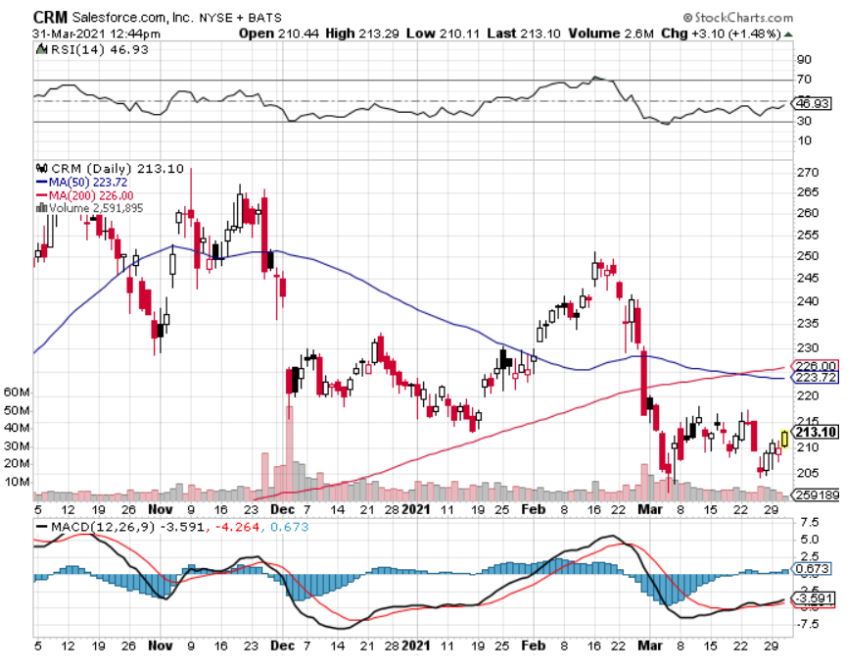The incredible secular trend toward digital is something a lot of CEOs talk about; and essentially, what happened last year might have taken a decade to happen in terms of the adoption of digital technology. Just take the Service Cloud at Salesforce (CRM) for an example.
Their digital service capability has grown at just unprecedented rates with the adoption of tools like chatbots powered by artificial intelligence software Einstein, they experienced a 91% quarter-over-quarter growth in chatbots alone.
Take data coming from Cyber Week this past quarter, mobile push notifications were up 131% year over year.
SMS was up 171% year over year.
The unprecedented adoption of digital really opens the playbook up for cloud companies and especially Salesforce.
Delivering success from anywhere has become their de facto motto.
Their revenue rose to more than $5.8 billion, up 20% year over year, which is expected but difficult for a company of their size.
And for the full fiscal year 2021, revenue was $21.25 billion which was up 24% year over year.
Salesforce even raised their fiscal year 2022 guidance to $25.75 billion which is now at the high end of their range, representing 21% projected growth year over year.
Salesforce’s long-term revenue target for the fiscal year 2026 is now $50 billion or basically, they plan to double the company from where we are right now.
Doubling revenue in five years would make Salesforce the second largest independent software company in the world which is breathtaking.
And a big part of Salesforce’s thesis as a company is, they’re not going back, I mean, not going back to business pre-Covid.
It’s really everyone who has experienced all these digital trends, whether it's bought online, curbside pickup, that direct-to-consumer trend in the consumer packaged goods industry, the move to telemedicine.
Salesforce is accelerating at such a rapid speed because the new world is here already, this work-from-anywhere world.
The great news for cloud companies is that they can achieve success from anywhere, but unfortunately, Salesforce is currently grappling with expensive M&A acquisitions that have penalized the recent price action in shares.
This includes costs like $190 million from Acumen, and $600 million from Slack.
For fiscal 2022, Salesforce expects an operating margin of 17.7% or flat year over year because of an expected 160 basis points headwind from Slack and Acumen.
Also, other heightened costs include investments in the core business and the anticipated gradual increase of travel in the second half of fiscal 2022.
The decrease in profitability will translate into much lower earnings per share (EPS).
As a result, this puts CRM stock on a high price-earnings (P/E) multiple of 48 which definitely isn’t cheap.
Last year, EPS was $4.92, up 64.6% from last year’s $2.99. But going forward, Salesforce forecasts that its EPS will be between just $3.39-$3.41 for 2022.
Real estate consolidation would also hurt their earnings in the year.
If you remember correctly, the company has splashed out on building Salesforce Tower in the middle of downtown San Francisco which gave them 1.4 million square feet of workspace.
Now, it sits unused because of remote work policies.
Salesforce is paying $27.7 billion in cash for the Slack acquisition which was considered way too much at the time and the all-cash transaction will mean the company will have to borrow at least $15 billion, since it has just $11.96 billion in cash and securities at the end of January 2021.
The consolidation in shares from $270 to $210 reflects the time needed to absorb these higher costs, lower profitability, and M&A transitions at a time when many cloud stocks doubled in 2020.
I do believe that when Salesforce turns around its profitability with higher trending EPS growth, stocks will gain sense of it and the direction will turn for the better.
That being said, most of the bad news is already in the stock, and we are getting close to the inflection point when Salesforce would be a favorable reversal trade.




